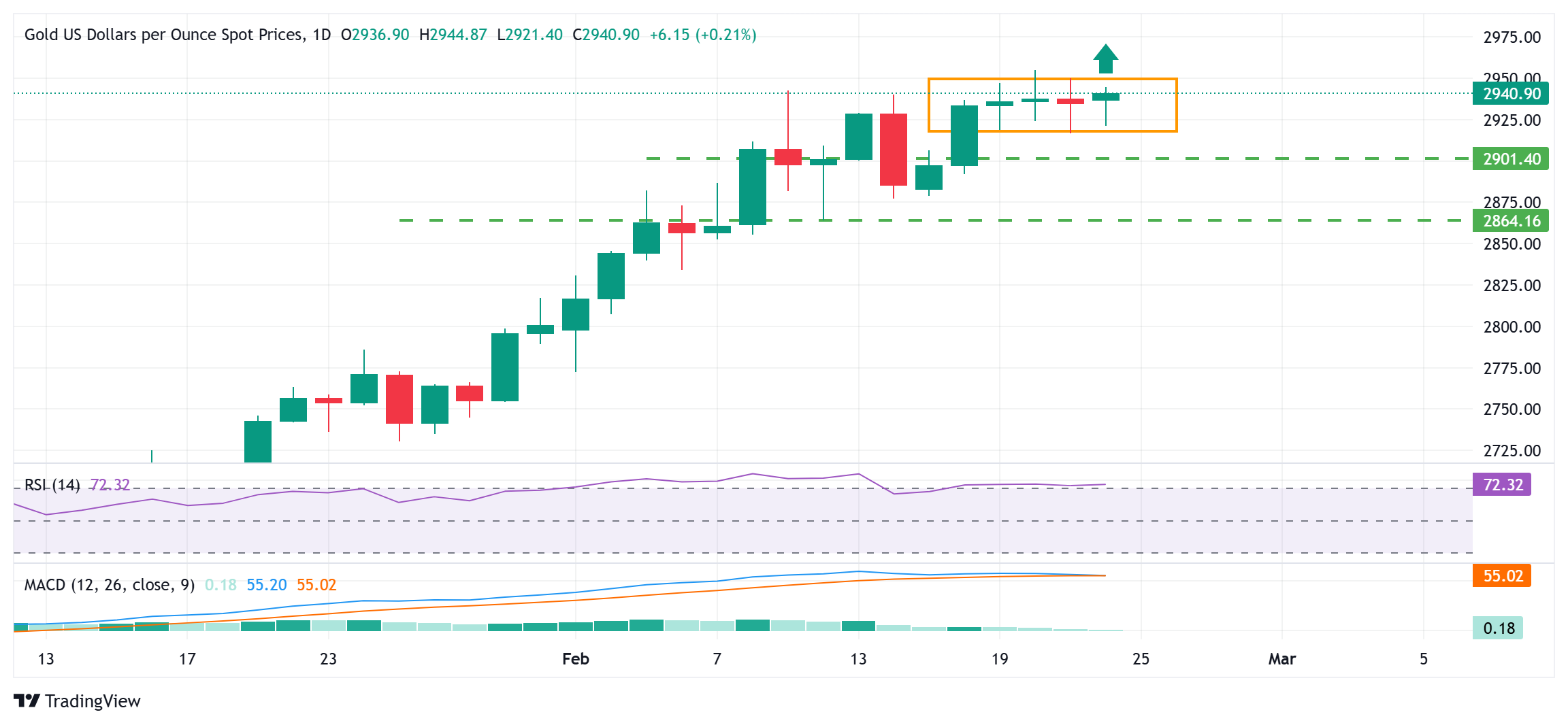Gold price remains confined in a multi-day-old trading range; sits near all-time peak

- Gold price continues to draw support from persistent worries about Trump’s tariff plans.
- The emergence of fresh USD selling and inflation concerns also underpin the XAU/USD.
- Hawkish Fed expectations keep a lid on further gains for the non-yielding yellow metal.
Gold price (XAU/USD) continues with its struggle to gain any meaningful traction during the Asian session on Monday and remains confined in a multi-day-old trading range near the all-time peak touched last week. The uncertainty surrounding US President Donald Trump’s trade tariffs and their impact on the global economy, along with the broader risk-averse theme, continues to act as a tailwind for the safe-haven bullion. Apart from this, geopolitical tensions and sustained US Dollar (USD) selling turn out to be other factors underpinning the commodity.
However, the growing acceptance expectations that the Federal Reserve (Fed) will keep interest rates higher for longer amid still-sticky inflation caps the upside for the non-yielding Gold price. Traders also seem reluctant to place aggressive bets and opt to wait for the release of the US Personal Consumption Expenditures (PCE) Price Index – the Fed’s preferred inflation measure – on Friday. The crucial data would provide more cues about the Fed’s rate-cut path, which, in turn, will drive the USD demand and determine the near-term trajectory for the precious metal.
Gold price traders seem non-committed; bullish bias remains amid trade war fears
- Concerns about the potential economic fallout from US President Donald Trump’s tariff plans assisted the safe-haven Gold price in registering gains for the eighth straight week and hit a fresh record high last week.
- Trump imposed a 25% tariff on steel and aluminum, and an additional 10% tariff on Chinese imports since taking office, and said last week that he would announce fresh tariffs over the next month or sooner.
- Data released on Friday fueled worries about the US growth outlook and dragged the US Dollar to its lowest level since December 10, which turns out to be another factor underpinning demand for the commodity.
- The flash S&P Global US Composite PMI dropped to 50.4 in February, from 52.7 in January, pointing to a weaker expansion in overall business activity across the private sector amid worries about Trump’s tariff plans.
- Separately, the University of Michigan reported that its US Consumer Sentiment Index dropped more than expected, to a 15-month low level of 64.7 in February compared to the previous month’s final reading of 71.7.
- Moreover, households saw inflation surging to 4.3% – the highest since November 2023 – over the next year, which turns out to be another factor that benefits the precious metal’s status as a hedge against rising prices.
- Stronger US consumer inflation figures, along with hawkish FOMC minutes, suggest that the Federal Reserve will keep rates steady for an extended period and act as a headwind for the non-yielding yellow metal.
- The release of the US Personal Consumption Expenditures (PCE) Price Index on Friday will play a key role in influencing market expectations about the Fed’s rate outlook and provide a fresh impetus to the XAU/USD.
- This week’s US economic docket also features the release of Prelim US Q4 GDP print and Durable Goods Orders on Thursday, which, along with speeches by influential FOMC members, will drive the USD demand.
Gold price needs to consolidate further amid still-overbought RSI on the daily chart

From a technical perspective, the daily Relative Strength Index (RSI) holds above the 70 mark and points to slightly overbought conditions. This might hold back traders from placing fresh bullish bets around the Gold price, which supports prospects for an extension of the range-bound price action. That said, some follow-through buying beyond the $2,950-2,955 area, or the all-time peak, would be seen as a fresh trigger for bulls and assist the XAU/USD to build on its recent well-established uptrend witnessed over the past two months or so.
Meanwhile, any corrective pullback might continue to attract some dip-buyers around the $2,920-2,915 region, or the lower end of a multi-day-old trading range. This is followed by the $2,900 mark and support near the $2,880 region, which if broken decisively could drag the Gold price to the $2,860-2,855 area en route to the $2,834 zone and eventually to the $2,800 mark.





